Welcome to March, the month where things start to happen in nature, flowers bloom, and animals are up and about.
This March will be very special indeed for another reason, for Saturn, who has been influencing us for some time, gives way for Pluto, who has not come into our lives in this way for centuries! Pluto is regarded as leading to change, in many ways, but also it clears things and allows us to move on, into areas that we may never have done if things were allowed to remain static. And to reinforce this, many planets are aligning amongst themselves in very unusual ways. So keep your eyes on the skies.
This week we have a number of cards that are unfamiliar to me, and some do not appear in the reference books either! It has been great fun trying to find them though.
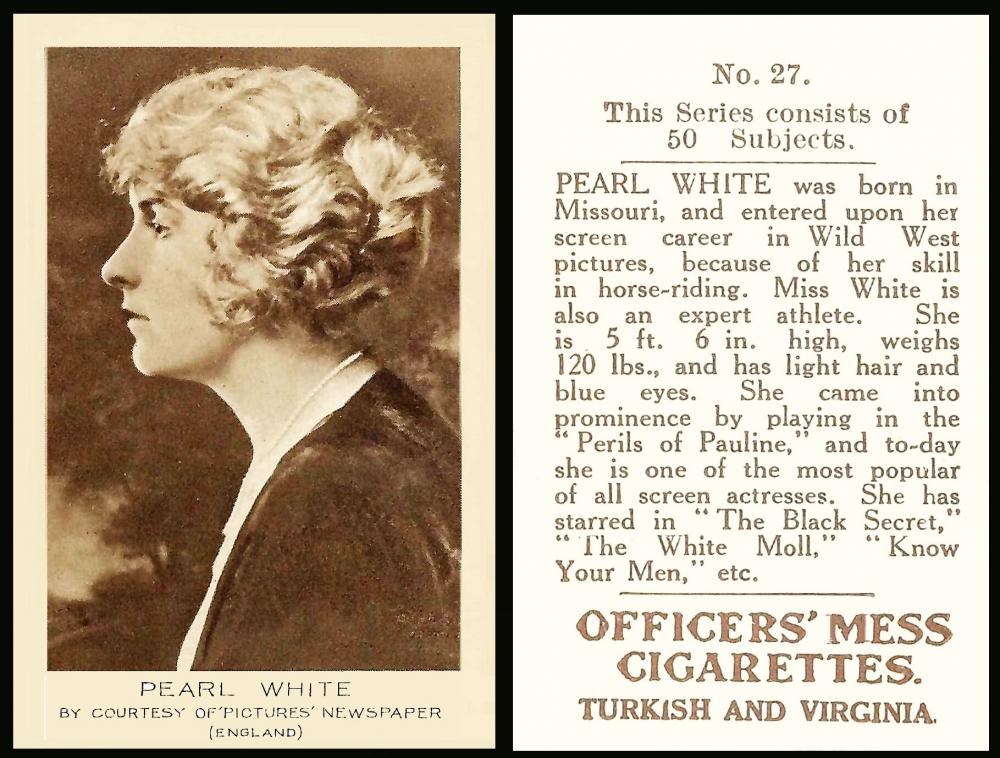
African Tobacco Manufacturers Co. [tobacco : O/S : South Africa] "Cinema Stars OMBI" first series (1923) 27/50 A210-040 : A20-12 : RB.21/263
Pearl Fay White was born today, in 1889, in Green Ridge, Missouri, into a farming family. They would later move to Springfield, in the same county.
She began her stage career aged just six, and joined the circus whilst in her early teens, galloping around the sawdust ring on an unsaddled horse. Slightly later she toured America with a theatrical company, she was just eighteen, and newly married, and it was this which led her into films. She signed first with Powers Moving Picture Company, which was started in 1910 as Powers Picture Plays. This name possibly tells us that its primary business was filming theatrical productions, which would have been how they encountered Pearl White - though at that time a lot of film companies and postcards referred to films being picture plays. In 1912 they were one of the companies who merged with The Independent Moving Pictures Company (also known as IMP) to form a new group called Universal Pictures Company. And they are still in business today, as Universal Pictures.
Pearl White was not at Powers very long before she moved to Pathe, where she found herself making mostly serials, the short films which were a weekly event, ending on a cliff top, making you wait seven days to see if your hero, or heroine, survived. In these she was known as simply Pearl White, though her fans called her "The Queen of the Serials".
She was reputed to do all her own stunts, and she did most of them, at first, but whilst making her most popular serial, "The Perils of Pauline" she hurt her spine, and it never healed. This made stunt work almost impossible for her to manage, and even riding was hard. Maybe because of this, she sought to move into more serious films, and in 1919, newly remarried, after a divorce, she joined with Fox. She made several films, but the public never liked her as much as they had when she was in the serials, and the truth is that it is harder to stand out in a serious film that it is to be a beautiful heroine, galloping across the plains, and swinging across the rivers. She was also once more divorced, in 1921.
After that she travelled to Europe and continued to make a few selected films. She also appeared on stage. But in 1924 she retired for good. She had made lots of money, and she started to develop a taste for the high life, frequenting and buying nightclubs and casinos, and she also took to horse racing in a big way. There was a new man, a businessman, who became her companion for the rest of her life, and encouraged her to return to films now that they were starting to talk. However for some reason this never happened. Some say her voice was unsuitable, and others that she had realised that she would still be expected to behave like she had in the serials, which was now impossible.
In the late 1930s she started to have great pain in her spine and it was discovered that she also had problems with her liver, she was known to drink quite heavily, and several other internal organs were damaged, perhaps by the rough and tumble of the early films she had made.
She died on August 4th, 1938, aged just forty-nine.
Our card is not the usual Bucktrout version, but an earlier one, issued in South Africa with Officers Mess brand, and that provides the O and the M of the code "OMBI". The B is Bucktrout and the I is a really scarce one issued by the Indo Egyptian Cigarette Company of Cheribon, in the Dutch East Indies. The two overseas versions were issued in 1922-23, wheread the Bucktrout did not come along until 1926-27. The series has no title in any of these printings, hence the acronym OMBI, made up of the manufacturers initials.
Our original World Tobacco Issues Index tells us that our version is
"Cinema Stars OMBI (A) Sm. 60 x 38. Brown photogravures. Nd. Officers Mess brand issues.
1A first set (50)
2A "Second Series" (50)
This is repeated in the updated version but it adds that the first series has the back in brown and the second in grey.
According to the TradingCardDatabase/PearlWhite she appears on twenty-two cards, but none of our three are listed.
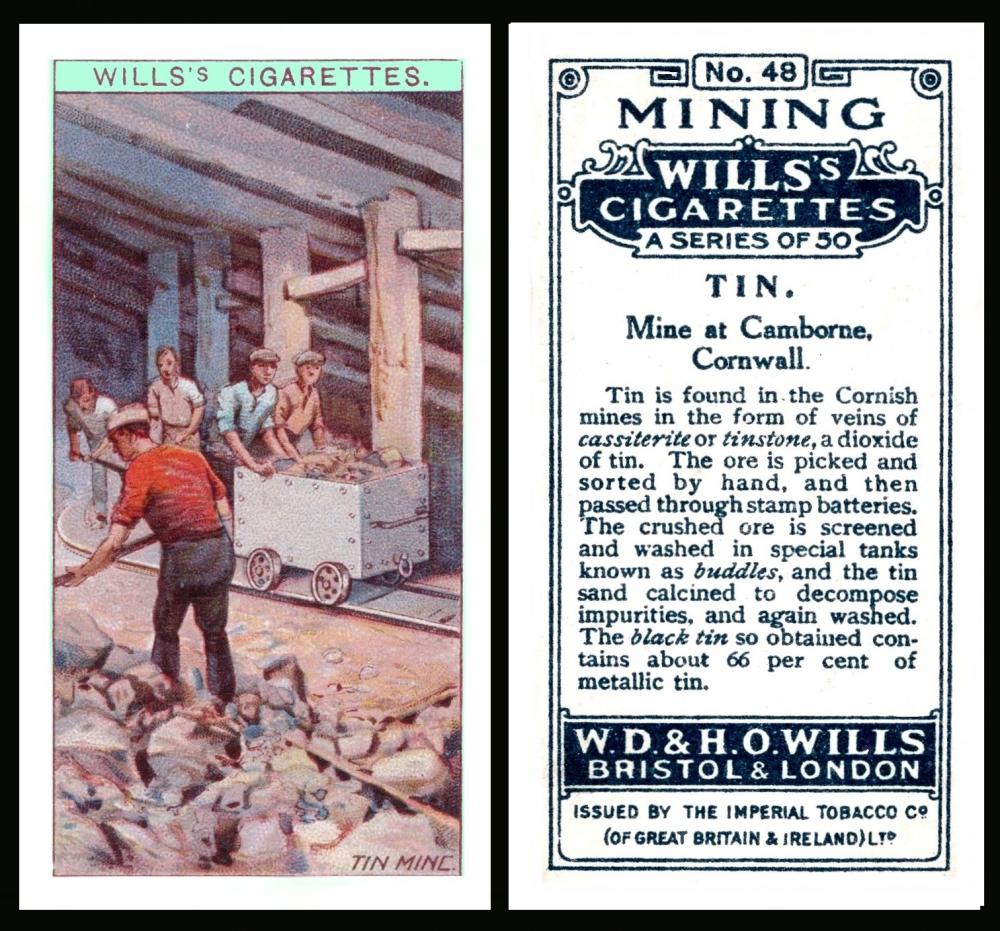
W.D. & H.O. Wills [tobacco : UK] "Mining" (June 1916) 48/50 - W675-122 : W62-89 : W/81 : H.450
Today is Cornwall Day, or St. Piran`s Day. And St. Piran was the patron saint of tin miners, who would take the day off to thank him for keeping them safe and bringing them the tin they dug. I have not been able to find out much yet but St.Piran was also reputed to have come across from Ireland and taught the local Cornish folk how to find tin, and how to refine it and make it into other products.
The holiday was a day, but the preparation for it could last a week before, which was called "Perrantide", and go on afterwards too. The day after was called "Mazy Day" or "Mazey Day", which seems to suggest a certain amount of drinking went on!
It seems natural that when Cornwall were looking for a National or County Day they would pick St Piran`s Day and resurrect it. The revival started after the Second World War in small ways, locally, but once rationing ended it started to become a more regional event. These days it is widespread across Cornwall and the flag of St. Piran is raised on many buildings, private and public.
This set appears in Wills Book three, but the month is not listed until all five Wills books are reprinted as a single volume. The listing for W/81 is
W.81. 50 Mining. Fronts lithographed in colour. Backs in grey with descriptive text. Home issue 1916. Similar series issued by Edwards, Ringer and Bigg.
The Edwards, Ringer and Bigg set was issued a lot later, in 1925, though this is almost certainly caused by the First World War.
By the time of our World Tobacco Issues Index the description has been shortened to simply "Sm. Nd. (50) See H.450" - and this is the same in the modern update of the Index.
By the way the H.450 code is the link to the handbook, but it only tells you that the set was also issued post 1920 by Edwards Ringer and Bigg
Tin Mining is also the industry chosen for John Player`s "Counties and Industries" - but Pattreiouex`s "The English and Welsh Counties" chooses the production of milk.
Now there is another reason for us adding this day into our Cartophilic Calendar, because some years ago we had a Cornwall Branch, which you can read about at https://csgb.co.uk/about/branches/cornwall - and if any of our readers were members or visitors, and this brings back any memories, please share them with us. Also if you have any souvenirs that you can scan so that we may include them.
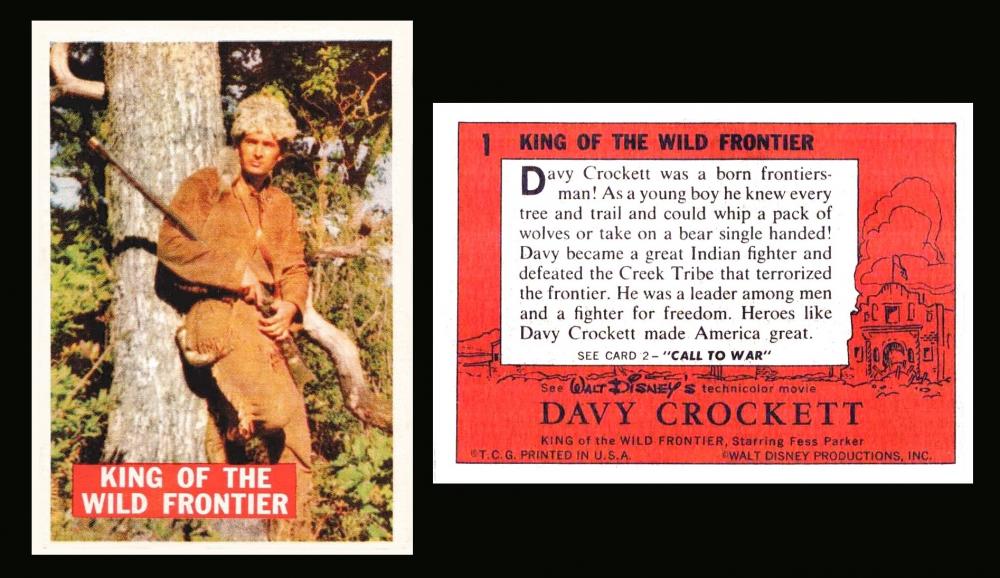
T.C.G. [trade/commercial : chewing gum : O/S : U.S.A.] "Davy Crockett" (1956) 1/80
Today in 1836 was the Battle of the Alamo, as fought by Davy Crockett. I imagine he looked rather different to Fess Parker, shown here, who played him in the Walt Disney series which this set commemorates.
His full name was Fess E. Parker Junior, and he was born in Texas. He only had the middle initial, but chose Elisha for himself to fill the gap. He was almost thirty when he started acting and thirty five when he played Davy Crockett. The serial was only three episodes long, but is now regarded as the first ever mini-series to be shown on television.
Strangely Fess Parker also played Daniel Boone in another television series that ran in the mid 1960s.
The Battle of the Alamo took place during the Texas Revolution, which started at the end of February 1836. What happened was that the area was once Mexican, and then Texans came along and tried to claim it as theirs. Hence the siege and battle, which the Mexicans won. The Alamo was just a small group of buildings, and a few cannons. Somewhere along the way Jim Bowie turned up, and also a newly unelected politician called David Crockett, who ended up getting killed, though nobody seemed to know (or care) whether he was killed in the fighting, or killed as a trophy afterwards.
These cards have shots from the film on one side, and descriptive text on the other. They are described as orange backed, but it tends to have gone to a redder colour, which makes reading the text quite hard. There was also a second series which had green backs, and are numbers 1A to 80A
Apparently the orange/red backs were very easy to make up a full set of, after which the gum was unsaleable. By the time that the green back set was issued it is said that steps had been taken to reduce this happening again, which sounds rather intriguing...
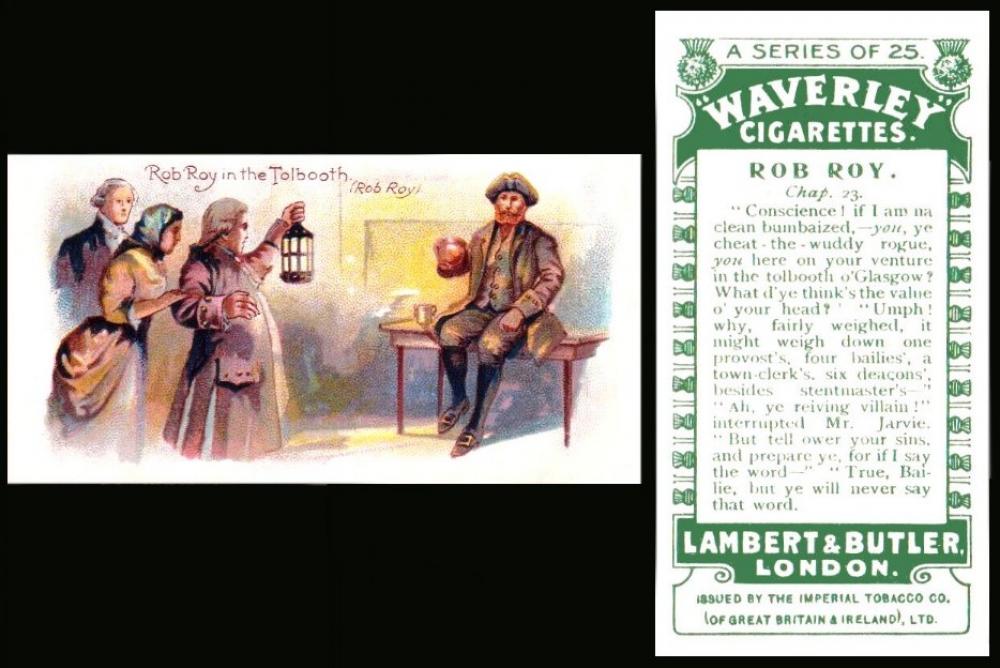
Lambert & Butler [tobacco : UK] "Waverley Series" (1904) Un/25 - L073-260 : L8-28 : RB.9/96 : H.255
Now sometimes you will read that Rob Roy McGregor was born today in 1734. The truth is that dates of birth were seldom even recorded - the thing that mattered was baptism, and today in 1734, that was what happened to him.
Now this set is known as the Waverley Series and yet it is not actually called that, look closer and you will see it actually says Waverley Cigarettes. And people are also often confused by the fact that the cards say "Chap...." and think that is the number, but that was not the intention at all and the cards are unnumbered.
Our original Lambert and Butler Reference Book, RB.9, issued in 1948, describes the set as :
96. Waverley Series (untitled) Unnumbered. Fronts lithographed in colour without photo basis. Backs in green with descriptions. 1904.
As the cards are unnumbered, they are listed in our handbook as H.255, and that shows us that there are actually three cards from the Rob Roy story, the other two showing Helen McGregor and The Escape of Rob Roy
You will also find Rob Roy on
-
Carreras "Highwaymen" (1924) 1/25
-
Mitchell's "Scottish Clan Series" (1903) 22/25
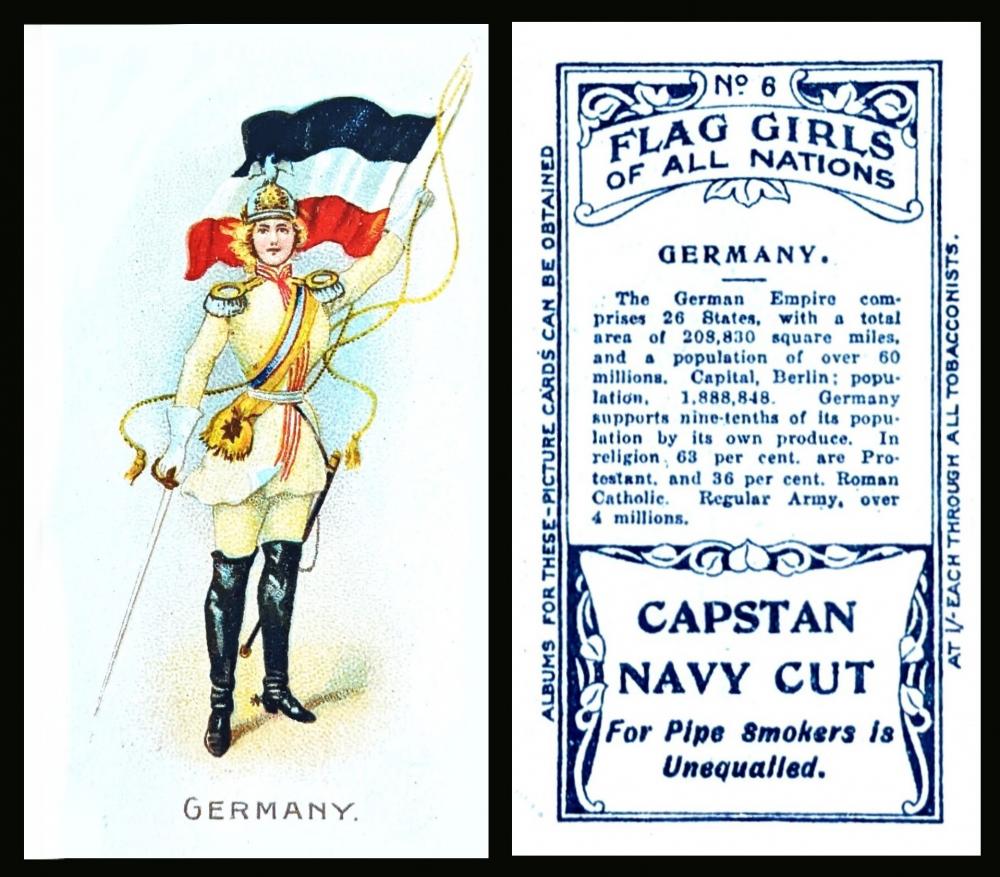
W.D. & H.O. Wills [tobacco : UK] "Flag Girls of All Nations" Capstan brand (1908-1910) 6/50 - W675-350 : W62-223 : W/64 : X21-200/64
To mark International Womens Day, which is today, here we have an amazing card showing a woman who indeed will fight for what she believes in.
And I am fascinated that while the other cards show ladies in National Costume, this German girl is in full military regalia, including a pickelhaube helmet with an eagle top. Is this a warning of Germany`s inevitable war with the other nations? It does seem to be.
This card was issued in Australia, and you can find it with either Capstan or Vice Regal brands. There is a great variety of blue ink shades used on the backs, which could point to the ink drying whilst they were being produced, or to it being reprinted several times. The titles also vary in size, at one time it was thought that you could find all fifty cards with either small or large title text, but it is now known that the first twenty-four cards can be found in either size, whilst the last twenty six are only in the larger size.
It was also issued in other parts of the globe with United Services and Scissors brands, and there is an anonymous version as well. And if that were not enough it was also issued overseas by Lambert and Butler and John Player as well as British American Tobacco, whose set is in medium size.
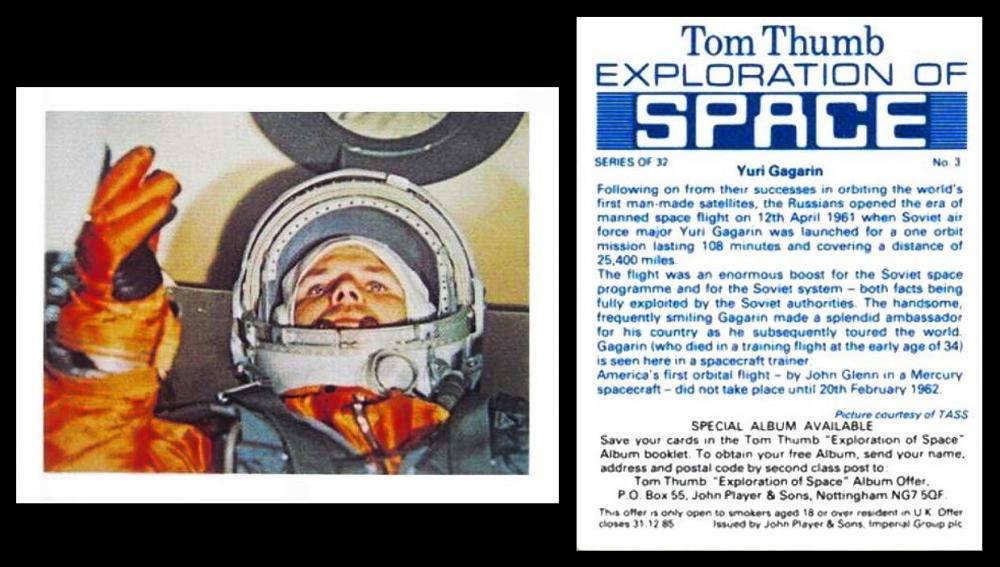
John Player [tobacco : UK] "Exploration of Space" (1982) 3/32 - P644-446
Yuri Alekseyevich Gagarin was born today in 1934. In his lifetime he saw himself become a huge hero in Soviet Russia and will always have the honour of being the first man to go into outer space, in Vostok I in April 1961. However at the time there were concerns that he would lose that honour; for he had ejected from the capsule on the way down and at the time the pilot and craft had to land together for the records to count. With this in mind, it was, at first, covered up that he had ejected, but by the time the truth became known the rules had loosened and the honour was still his.
Gagarin started out as a humble steelworker, but had always been interested in flying, making model aircraft as a child and being set on flying in the future for real. He volunteered at a flying club as soon as he could, and then joined the Soviet air force, where he eventually became a pilot. There he was picked out as having something special, and sent to join the space programme. Vostok 1 was his only flight to outer space, though he did hope to join the Soyuz 1, with his friend. Sadly this mission was unsuccessful and his friend was killed. After that Gagarin was seen as too important to allow into space again, and there were thoughts that he would be banned from flying at all. However this was relaxed after he had undertaken further detailed training. But a few weeks later, in March 1968, he "died in a training flight at the early age of 34", a fact that has led to many conspiracy theories.
Only one code, for this set was issued almost thirty years after our original World Tobacco Issues Index.
These attractive cards measure 74 x 57, so fall under the medium size, and special albums were issued, which were free of charge, though you had to send away for them.
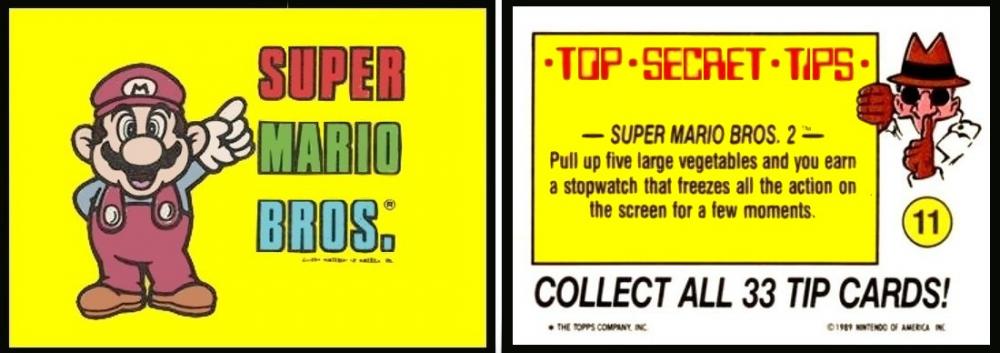
Nintendo Super Mario Bros Game Tip Stickers (1989) 11/33 -
I had lots of trouble with this card, it came out way too large. But it is changed now, reduced and set up side by side instead of one above the other
This day is a real play on words and numbers, because today, Mar.10, it is National Mario Day, Mario being a plumber in a video game of the 1980s. The original game was called Mario Brothers, because Mario had a brother Luigi, and it was developed by Nintendo for playing as a game in amusement arcades. This was a huge hit, and led to Super Mario Brothers three years later.
Since then the characters have appeared in home computing, as well as on television and film, both as animated characters and as actual people. And they also appear on trading cards, such as ours, which is actually a peelable sticker, issued by Topps in conjunction with Nintendo, in 1989. These measure 55 x 77 m/m. As well as the peelable stickers, there are scratch off cards, with small silver circles, and they reveal hidden images beneath. As to why these were released in 1989, well I think it was to tie in with The Super Mario Bros. Super Show ! - that was a television series that was shown in America starting in September 1989. It was very popular and had some incredible guest stars, many of whom played themselves.
Impel also issued a set in 1991. These have black borders with red corners and were issued with a promotional message that advertises The National Safe Kids Campaign, which concentrates on preventing accidental injuries.
In 1992/93 the first live action film appeared. It was released in Australia first, so their cards appeared in 1992. These were issued by Skybox and show the actors, but some people prefer the cartoon images. I have to say I do as well. Mario was played by Bob Hoskins and Luigi by John Leguizamo. Dennis Hopper also appeared.
This week's Cards of the Day...
led you to "March", the month !
So our first clue card was :
Saturday, 25th February 2023

Kane Products Ltd were based in London and East Grinstead. This card measures 67 x 35 m/m and it is from a numbered set of twenty-five cards
Our man gave the first clue from his surname, for he is Toni Marchi, of Tottenham Hotspurs. Now to me that extra "s" in Hotspur"s" seems odd, though I know that they are called "Spurs". Can anyone find, or does anyone know, a time that they were called Tottenham Hotspurs? If so let us know.
Toni Marchi, or Anthony Marchi was born in Edmonton, North London, on the 21st of January 1933. He started with Tottenham Hotspur Youth Squad in 1947, then moved up to the Seniors two years later, and stayed there for fifteen years, though as the card predicted he did move to Italy, in 1957, the year of this card. However he did not sign for Lanerossi Vicenza after all, but for Juventus, (some three hours drive away). Juventus seem not to have ever put him on a squad, but they did loan him out to other teams. And I have not found that he was on the Italian National Squad either, as predicted on this card. That is possibly why he returned to English football, and to Tottenham Hotspur, in 1959, and stayed there until 1965.
Then instead of going to another team as a player he turned to managing, Cambridge City for a couple of years and then a year at Northampton Town.
The TradingCardDatabase/Marchi has him on five cards. There is another, a series of paper cards issued by the Sunday Express as sheets to be cut down, or maybe even printed within the paper. Maybe a reader can tell us more? The card of Tony Marchi is headed The Italian Collection but there seems to be several sub sections of the set with different headings. The descriptive text on this card says he "Didn`t enjoy Italian Football".
He died in March 2022, aged eighty-nine.
Sunday, 26th February 2023
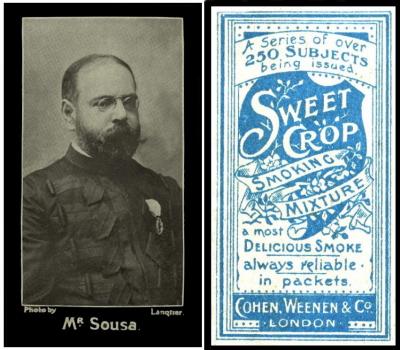
Here we have John Philip Sousa, born in 1854, and known as The March King, but nothing to do with the month, this referred to his music, and specifically the kind of stimulating regular tunes that a group could march to. Some of his best known marches are "The Stars and Stripes Forever" and "Semper Fi" (actually Semper Fidelis, and this is the official march of the U.S. Marine Corps as well as the National March of the United States of America. He would be proud of the fact that the Marines still use it, for he started his career in the United States Marine Band,
He was a proficient musician on many instruments, and also helped to invent one, the Sousaphone. By Saturday we will have found one of these on cards, but it is proving elusive tonight!
Added March 15th, 2023 : Since writing this post we have found out something rather amazing, and that is that in 1925 the company of P. Lorillard advertised a cigar called "The March King", which retailed for the price of three cents each (five for 15c). In these adverts could plainly be seen the face of the actual March King, John Philip Sousa, sometimes contemplating the cigar and sometimes actually smoking one. His face also appeared on the label of every cigar.
However Lorillard had not asked his permission first, so in May 1925 Sousa sued them, took them to the Supreme Court no less, and asked for $100,000. His case rested on the facts that they had trespassed on his name, made him the butt of jokes amongst his friends and future employers. Worst of all they had insulted him by attaching his name to a cheap cigar when it was common knowledge that his favoured brand was Fonseca`s "McKinleys", named after the President, and specially imported from Havana.
In the end the matter was settled out of court, and the cigar was removed from sale.
H. Cohen, Weenen, & Co. was one of the smaller tobacco companies, and were established in 1864, in Brown`s Lane, in Spitalfields, East London. They stayed quite small, hoping to gain a niche market rather than fight against the might of the larger companies.
One thing we have uncovered is that on the 24th of February 1869 the partnership between Henry and Solomon Cohen, and Alfred Weenen, Importers and Manufacturers of Cigars, was dissolved. More excitingly, Solomon Cohen did not sign his name to this document, but made a mark, signing with a cross.
The gist of the matter was that the Cohens were going to continue with a company called H & S Cohen, but Alfred Weenen was not coming along. All the documents state this to have been by mutual consent, though it does say one strange thing, that being that "all debts due.to and owing by the said late copartnership will be received and paid by the said Henry Cohen and Solomon Cohen". So maybe Mr. Weenen had exceeded his means one too many times?
Despite this, the name on the cards and the tobacco remained the same, Cohen Weenen, from 1891-1923.
Then in 1927, they became a limited company, but were taken over four years later by Godfrey Phillips. Whether this had anything to do with a lawsuit in America over some tobacco that had been damaged in the recent storms, is unclear.
Godfrey Phillips were bought out by Phillip Morris in the late 1960s
The main Cohen Weenen brand was "Sweet Crop", through which most of their cards were distributed. Some of their other brands were :
- "Afrikander" (tobacco - 1930s - sold in various styles, including "Colonial Flake" and "Smoking Mixture")
- "Bishops Move"
- "Classic Curly Cut" (tobacco)
- "Dames" (cigarettes -1890s),
- "Gaiety Girl",
Our original World Tobacco Issues Index describes this set as
Celebrities - black and white (A) sm. 67 x 36. Un`nd (65) See H.88
(A) "over 250" back
(B) "over 500" back
The (A) means that the set is actually untitled, but was given the title of Celebrities by early researchers. You will note that the (A) follows the "black and white" - this is because there were two sets that were given this name but the other one showed the subjects in colour.
An almost identical description appears in our updated World Tobacco Issues Index, except that it adds the fact that all sixty-five cards are known in set (A), whereas only nineteen are known with the "over 500" back. All the subjects are listed in the handbook under H.88, but I have been unable to find out which of them appeared on the "over 500"s and formed the nineteen. If anyone out there has a card like this with an "over 500" back maybe you could let us know the title on the front and we will start a list....
Monday, 27th February 2023

Now here we have a medal awarded for a March, which took place towards the end of The Second Anglo Afghan War. And you can read about that at GarenEwing/March. This medal is actually known not as Roberts March Medal, but as The Kabul to Kandahar Star, (though you may come across it listed as the Roberts Star, or the Kandahar Bronze Star), and it was awarded to all participants of the three hundred and twenty mile march, which took twenty-two days. as well as those who joined en route and "only" walked the last ninety miles.
The Richmond Cavendish Co. Ltd were based in Liverpool. They were founded in 1861 but most of their product was destined for overseas export. And they were a founder member of the Imperial Tobacco Company. And yet few collectors seem to know of them, nor their cards.
This very attractive set is much more curious than I thought. It is described in our original World Tobacco Issues Index as
Medals (A) Sm. 71 x 33. Un`nd (40). See H.200. Inscribed at base of text "Pioneer Cigarettes". Cards also found with this inscription cut off.
And the same text appears in our updated version.
H.200, the handbook, gives a list of all forty cards, but also something very intriguing as it says the set was also issued by Hignett. And looking this second set up, in both versions of the World Tobacco Issues Index, says the same thing, that the cards were also found with the lower bar, within the border, the one which says "Butterfly Cigarettes", being cut off.
Now if you look at the various internet auctions you will sometimes find the Hignett and the Richmond Cavendish cards with two bars and with one, and you might think that this is done more recently to cover up damage, etc.
However, there is a secret which is only revealed in the London Cigarette Card Company Catalogue for 1950 and only then under Hignett. This gives a date of issue of 1901-1902, and two prices - (A) being "Butterfly Cigarettes", and B) saying "officially cut for use with other brands".
So it seems likely that these Richmond Cavendish cards were also cut by them to remove the "Pioneer Cigarettes" identification. Though it does seem odd that Hignett issued several brands, but Richmond Cavendish seem only to have had Pioneer.
Tuesday, 28th February 2023

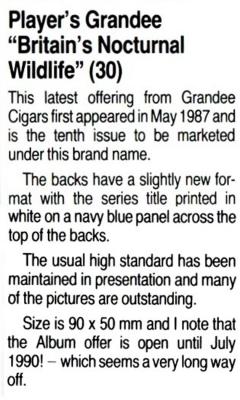
This write up. left, comes from our magazine "Cartophilic Notes and News", issue number 144, for July/August 1987.
This same set was also issued with a different brand, Doncella.
Both of these brands were actually cigars.
Notice that there is only one code tonight, because this set was issued almost thirty years after our original World Tobacco Issues Index. Our updated version catalogues it under John Player section 3B, "Grandee Series. Md. 89 x 92" and tells us that the later series, including ours, are "similar to Doncella Issues". Also that "special albums [were] issued". However all it says in the listing of this set is "Britain`s Nocturnal Wildlife. Nd. 30."
"Md" is, of course, medium sized. But in a dealer`s catalogue you might find it shown as "T30", and T simply refers to the size of plastic leaves that they fit in to.
Our card, a hare, reminds us of the saying "as mad as a March Hare". I am certain you have heard it, but did you know where it came from and who said it first? We will tell you in our weekly newsletter on Saturday morning.
The phrase does have its basis in nature, for March is when the hares start to breed, and the male hares, as most males tend to do, think that they will attract a mate by being loud and showing off, and leaping about madly, fighting each other if they can. And the lady hare realises that in the end she will have to pick one of the fools, or be lonely.
Wednesday, 1st March 2023
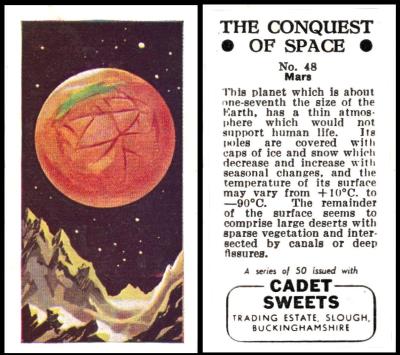
Here we have the planet Mars, but the month of March is named after his namesake, the God of War.
Now I asked when this card appeared first as the card of the day if you knew why Mars, the God of War, had the honour of having the month names after him? Well, if you didn`t, it is for a very serious reason, that being that due to the climate, any wars being waged would stop for "Winter" and resume in March. If you have ever seen Roman Legionnaires you can understand this,for they are rather scantily clad, just a skirt and bare legs, and their metal helmet, and armour, was really cold against their flesh
The Romans knew of this planet, they saw it shining above them in the sky, and as it was red, and did not look peaceful, it was named after their God of War.
There is another link to the God too, because he steered a chariot pulled by two horses, Phobos and Deimos (those names translate to Fear and Panic). Anyway when it was discovered that the planet was accompanied by two small moons, they were named after those horses.
Now this set is hard to find in our British Trade Indexes because it appears between "Buccaneers" and "Daktari". In our original part II, the listing reads :
THE CONQUEST OF SPACE. Sm. Nd. (50) See D.256.
A. Size 64 x 35 B. Size 69 x 37.
The "D" code tells us immediately that this is a duplicated set, issued by at least one other manufacturer. In this case there are three others,
-
Beano - Bubble Gum - London (68 x 38 m/m) - issued in 1955
-
Brookfield - Sweets - Dublin (69 x 37 m/m) - issued in 1956
-
Lipton - Tea - London (68 x 38 m/m) - issued in 1962
In our updated British Trade Index, the listing reads :
THE CONQUEST OF SPACE. 1957. Nd. (50) Two sizes, a) 64 x 35 b) 69 x 37. See HX-73.
Thursday, 2nd March 2023
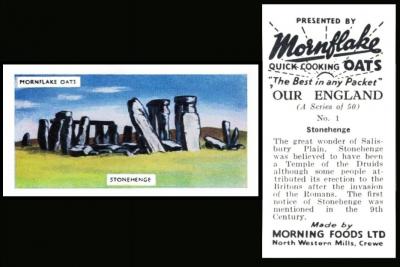
Here we have Stonehenge, because in March, at the time of the Spring Equinox, many people gather there to see the sun line up through the monoliths. It is an amazing sight.
The first thing you will find out is that Mornflake Oats is not listed in our reference books. The sets issued by them are listed as Morning Foods Ltd, of North Western Mills, Crewe, Cheshire.
Our British Trade Index part one has this as MON-7, "Our England. Sm. 68 x 36. Nd. (50)". However part two says that code is wrong, it was inserted out of order, above I & R Morley Limited`s MOW-1 and it should have been below it as MOPW-7. Then in part four it sorts it out once and for all by giving our set the code of MOWD-7.
In our updated British Trade Index all that is forgotten, and the code is given as MOR-210. The description is "Our England. 1956. Sm. 68 x 36. Nd. (50)".
Friday, 3rd March 2023
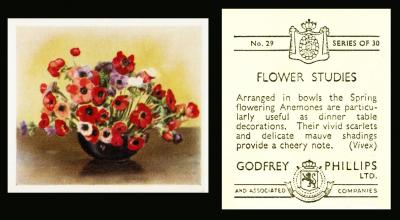
This is the anemone, which comes into flower in March.
Our set appears in the original Godfrey Phillips Reference Book RB.13, issued in 1949. There it is described as :
80. 30 Flower Studies. Fronts printed by letterpress in colour. Backs in black with brief descriptive text. The series was issued in two sizes:
A) medium cards, size 61 x 53 m/m. Cards entitled "Flower Studies". Issued 1937
B) postcard size 128 x 89 m/m. Backs in postcard format. No series title appears on the cards. This series has previously been known as "Cut Flowers". Home and Export issue. 1937.
I have not been able to find this set in dealers listings with the "Cut Flowers" title, but something may turn up as I go through my library one day.
There is another fascinating fact about this card, and that is where it says "Vivex". For this was a very early form of colour photography, invented by a research chemist called Dr. Douglas Arthur Spencer, and right up until the Second World War it was the main source of all colour images. The process was very curious as well, for it used three coloured negatives (blue, red, and yellow) on cellophane, from which the images were washed off after a certain time, but it was found that they had magically left behind an image in almost three dimensional form.
well readers, it looks like this will again be uploaded at the right time. So I will not tarry with a lengthy outro, I will just hit the send.
But, as always, if anyone knows any more info, just let us know at webmaster@card-world.co.uk and we will add it in. You can be anonymous if you wish as well.
